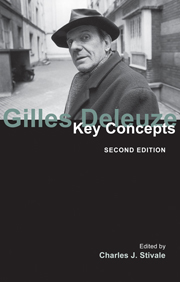Book contents
- Frontmatter
- Contents
- Contributors
- Acknowledgements
- Abbreviations
- Introduction: Gilles Deleuze, a life in friendship
- PART I PHILOSOPHIES
- PART II ENCOUNTERS
- 5 Sense, series
- 6 Event
- 7 Assemblage
- 8 Micropolitics
- 9 Becoming-woman
- 10 The minor
- 11 Style, stutter
- 12 The logic of sensation
- 13 Cinema
- Part III FOLDS
- Chronology
- Bibliography
- Index
12 - The logic of sensation
from PART II - ENCOUNTERS
- Frontmatter
- Contents
- Contributors
- Acknowledgements
- Abbreviations
- Introduction: Gilles Deleuze, a life in friendship
- PART I PHILOSOPHIES
- PART II ENCOUNTERS
- 5 Sense, series
- 6 Event
- 7 Assemblage
- 8 Micropolitics
- 9 Becoming-woman
- 10 The minor
- 11 Style, stutter
- 12 The logic of sensation
- 13 Cinema
- Part III FOLDS
- Chronology
- Bibliography
- Index
Summary
How well we have learned that the task before us is the search for meaning. As young children we are taught to accept that words have meanings, to recognize the moral of a tale, to search for the meaning of a poem or the significance of a story. As we become more sophisticated, we may even learn to probe the hidden meanings of visual imagery or the complex significance of non-representational art forms. At some point, however, we may stand perplexed in the inadequacy of our tools, perhaps before a work of abstract visual art or a plotless novel, where in wonder, frustration, or disgust we find ourselves unable to answer with familiar satisfaction the question, “What does it mean?” Or we may glimpse the fact that in our habitual search for the meanings of things we have learned not to ask certain “irrelevant” questions: what is the meaning of a hiccup? Of cool rain on warm skin? Of a tear? Of a scream? Of an angry expression? Of a barn on fire?
But even as I key these questions into my computer, I know, as Deleuze has written, “A story always slips into, or tends to slip into, the space between two figures in order to animate the illustrated whole” (FB: 6).
- Type
- Chapter
- Information
- Gilles DeleuzeKey Concepts, pp. 153 - 162Publisher: Acumen PublishingPrint publication year: 2011

